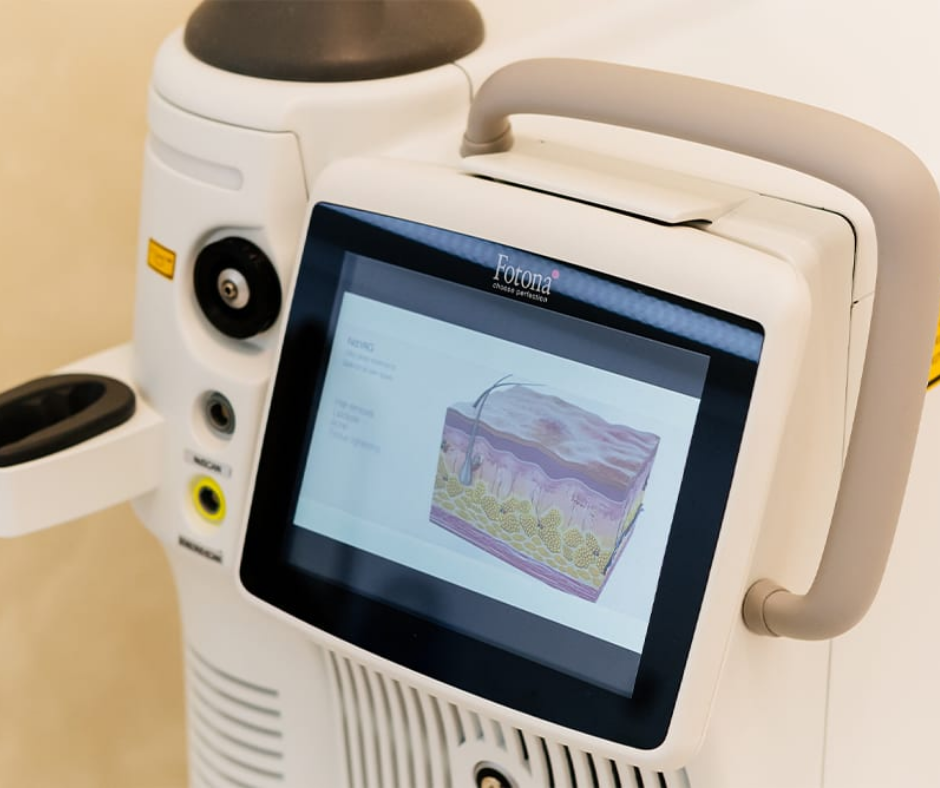
Laser Blood Vessel Removal
Laser treatment of vascular abnormalities with Fotona SP Dynamis system
Indications
Couperose
Rosacea
Hemangiomas
Angiomas
Varicose veins
Vascular pathologies like couperose, telangiectasia, hemangioma, rosacea, wine spots, angioma, etc. bring considerable discomfort, because they are almost impossible to be corrected by the classic methods of aesthetic cosmetology and are very difficult to mask. Apart from the fact that such defects must be solved at body level, every owner of vascular signs dreams to forget about them, if not forever (sometimes it is impossible), then for a long period of time for sure.
Is there a modern solution for vascular pathologies?
Today laser treatment of vascular pathologies ranks highly in the practice of cosmetic surgeons and improves steadily, aiming for maximum comfort, efficiency and safety. FOTONA SP DYNAMIS neodymium long-pulse lasers offer a perfect solution for treating vascular anomalies. The neodymium lasers of the FOTONA system penetrate the skin to a depth of 5-6 mm, which greatly increases the treatment effectiveness. Independent studies have shown that more than 75% of patients with deep hemangiomas show dramatic regression of the elements after Nd:YAG laser treatment.

Do you want to get more information?
Benefits of using the FOTONA system
FOTONA SP DYNAMIS lasers make a real difference by providing fast, highly effective and high-quality results in vascular pathologies. All FOTONA neodymium lasers are equipped with VSP (Variable Square Pulse) technology, which allows the laser energy to penetrate deep into the skin, creating thermal effects without damaging the surface structures of the skin. Compared to conventional Nd:YAG technologies, FOTONA’s patented VSP pulses create an almost instantaneous temperature increase limited only to the target structures; they do not accumulate energy in the surrounding tissues, leaving them intact. This fact also guarantees a quick recovery after the procedure and maximum shortening of the rehabilitation period.

What is the mechanism of action?
In vascular lesions, the target is the intravascular chromophore, oxyhemoglobin. Thus, thermal damage is largely confined to the cutaneous blood vessels. The laser energy is absorbed by the venous blood, converted into heat, after which the vessel walls stick together, coagulation and destruction occur. Small capillaries disappear without a trace under this influence, while larger vessels first darken and then disappear. Large hemangiomas, on the other hand, lose significantly in color intensity, but are not always completely correctable.
Compared to other wavelengths, which mainly affect the surface structures of the element, neodymium light affects the underlying vascular supply, which is important for long-term treatment effects. This process is completely safe, as the healthy vessels take over the role of blood supply and nourishment of the treated area, and the body’s immune system removes the dead structures, in the same manner it does with a bruise.
How long does a laser therapy session take?
The duration of the session depends on both the element itself and the number of elements
10 to 30 minutes
On average 10 to 30 minutes
Individual schedule
As prescribed by the specialist
How does the procedure go?
The first stage is when the specialist removes the makeup and cleanses the treated area. Then, the conductive gel is applied and special glasses are put on to protect the eyes from the laser beam. The final stage is direct treatment of vascular elements with the laser energy in a given set of parameters.


Is the procedure painful and how does the surface look after treatment?
We do our best to provide maximum comfort to our clients. Therefore, we also use a machine which provides a cooling effect during this procedure. This minimizes discomfort during the protocol, as well as the risk of tissue overheating and burns.
Immediately after the session redness of the treated skin area may persist for some time. When working with deep elements, formation of dense scales/thin crusts or peeling is possible.
Is one treatment enough or do you need a course?
It is impossible to answer this question unambiguously. Your doctor will evaluate each vascular element individually and during the initial consultation he or she will give you the estimated terms of the correction. Besides, the patient will get personalized recommendations on the treatment of the area, treated with the laser.


